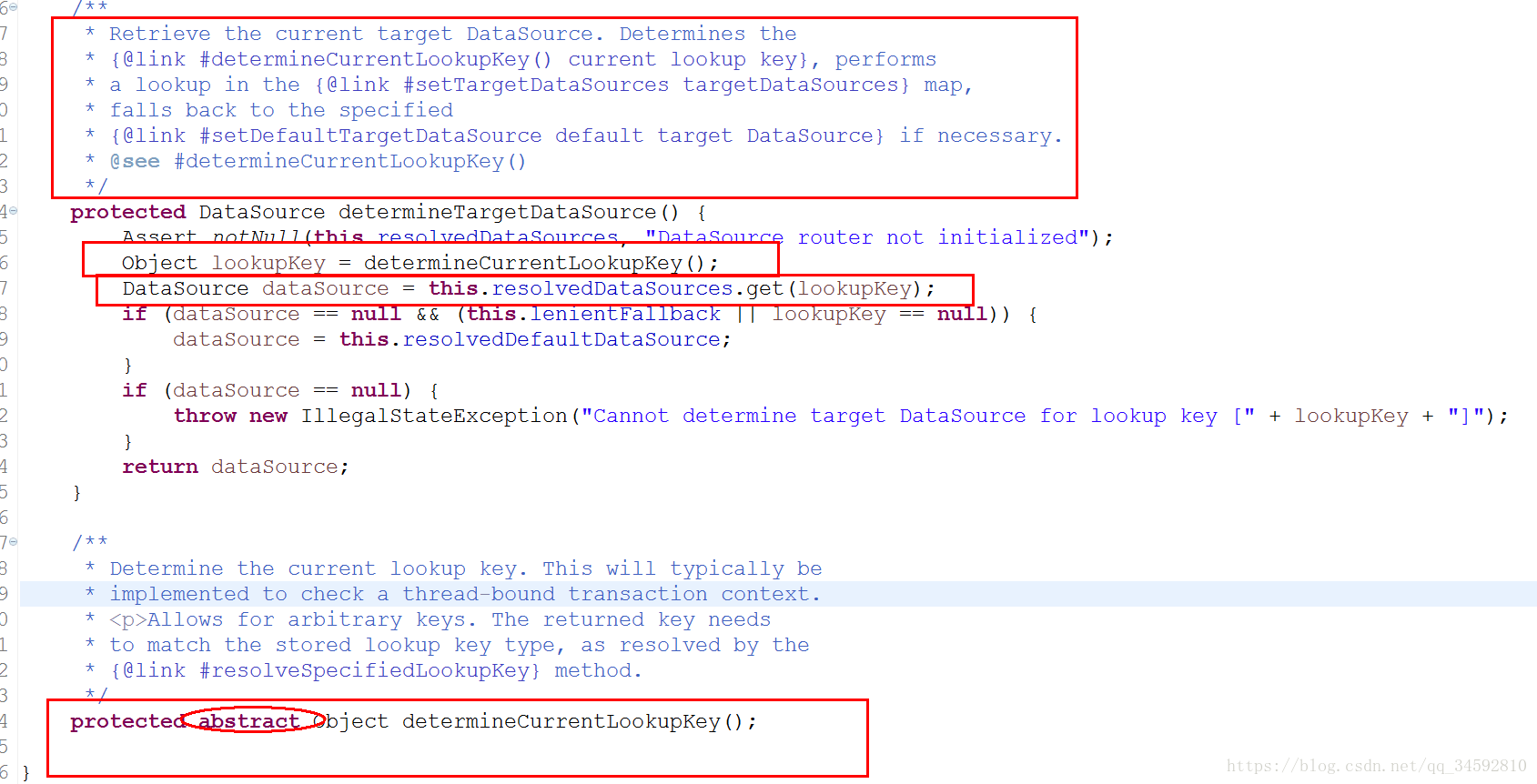【原创】SSM框架(2):多数据源支持,动态配置依赖的数据源
一、SSM框架配置多数据源的原理
原理:MyBatis在创建SqlSession时,动态的使用不同的dataSource,就可以动态的使用不同的数据源。
那么,怎样才能动态的使用不同的dataSource呢? 在Spring框架中,提供了一个类AbstractRoutingDataSource,顾名思义叫做路由选择。该类AbstractRoutingDataSource继承AbstractDataSource,AbstractDataSource又实现了DataSource,因此,可以使用AbstractRoutingDataSource来完成我们的需求。AbstractRoutingDataSource中有一个determineTargetDataSource()方法,该方法是用来决定目标数据源的;而determineTargetDataSource()方法中通过determineCurrentLookupKey()方法来决定lookupKey;然后使用封装好了的map集合resolvedDataSources,通过lookupKey为key值取得dataSource。因此这里面最重要的就是determineCurrentLookupKey()方法获取key值,在这里Spring把这个方法抽象出来,交给用户来实现。

二、实践:在SSM框架中,实现多数据源访问(目录结构如下图)

1、第一步:搭建SSM项目
搭建步骤参考:SSM框架(1):使用Maven搭建SSM项目实践
2、创建动态数据源代理类:DynamicDataSource 和 DynamicDataSourceHolder
- DynamicDataSource:实现Spring定义的路由选择抽象类AbstractRoutingDataSource,用来创建动态的数据源。
- DynamicDataSourceHolder:用来保存数据源标识,从而在实例化DynamicDataSource时,来指定要使用的数据源实例
package com.newbie.util; import org.springframework.jdbc.datasource.lookup.AbstractRoutingDataSource; /** * DynamicDataSource由自己实现,实现AbstractRoutingDataSource,数据源由自己指定。 */ public class DynamicDataSource extends AbstractRoutingDataSource { @Override protected Object determineCurrentLookupKey() { // 从自定义的位置获取数据源标识 return DynamicDataSourceHolder.getDataSourceKey(); } }
package com.newbie.util; /** * 自定义类:用来保存数据源标识,从而在实例化DynamicDataSource时来指定要使用的数据源实例 */ public class DynamicDataSourceHolder { /** * 注意:数据源标识保存在线程变量中,避免多线程操作数据源时互相干扰 */ private static final ThreadLocal<String> DATA_SOURCE_KEY = new ThreadLocal<String>(); public static String getDataSourceKey(){ return DATA_SOURCE_KEY.get(); } public static void setDataSourceKey(String dataSourceKey){ DATA_SOURCE_KEY.set(dataSourceKey); } public static void clearDataSourceKey(){ DATA_SOURCE_KEY.remove(); } }
3、自定义多数据源注解@AnnotationDBSourceKey 以及 解析数据源注解的切面类DynamicDBSourceAspect
- AnnotationDBSourceKey:自定义注解类。在要动态设置数据源的方法上,使用注解来标识数据源。
- DynamicDBSourceAspect:切面类。在执行横切的方法前,获取方法的@AnnotationDBSourceKey注解,解析注解的值来设置DynamicDataSourceHolder类中的数据源标识,进而达到动态设置数据源的目的。
package com.newbie.util.annotation; import java.lang.annotation.ElementType; import java.lang.annotation.Retention; import java.lang.annotation.RetentionPolicy; import java.lang.annotation.Target; /** * 自定义注解类型:使用注解来标识数据源 */ @Target({ElementType.TYPE,ElementType.METHOD}) @Retention(RetentionPolicy.RUNTIME) public @interface AnnotationDBSourceKey { /** * value的值:来标识数据源 * @return */ String value(); }
package com.newbie.util.annotation; import com.newbie.util.DynamicDataSourceHolder; import org.aspectj.lang.JoinPoint; import org.aspectj.lang.annotation.Aspect; import org.aspectj.lang.annotation.Before; import org.aspectj.lang.reflect.MethodSignature; import org.springframework.stereotype.Component; import java.lang.reflect.Method; /** * 定义切面类:在执行DAO接口的方法前,获取方法的@AnnotationDBSourceKey注解,根据注解的值来动态设置数据源 */ @Component @Aspect public class DynamicDBSourceAspect { /** * 拦截目标方法,获取由@DataSource指定的数据源标识,设置到线程存储中以便切换数据源 * * @param point * @throws Exception */ @Before("execution(* com.newbie.service.*.*(..))") public void intercept(JoinPoint point) throws Exception { Class<?> target = point.getTarget().getClass(); MethodSignature signature = (MethodSignature) point.getSignature(); System.out.println("intercept()----,target:"+target+",signature:"+signature+",signature.getMethod():"+signature.getMethod()); // 默认使用目标类型的注解,如果没有则使用其实现接口的注解 for (Class<?> clazz : target.getInterfaces()) { resolveDataSource(clazz, signature.getMethod()); } resolveDataSource(target, signature.getMethod()); } /** * 提取目标对象方法注解和类型注解中的数据源标识 * * @param clazz * @param method */ private void resolveDataSource(Class<?> clazz, Method method) { try { Class<?>[] types = method.getParameterTypes(); // 默认使用类型注解 if (clazz.isAnnotationPresent(AnnotationDBSourceKey.class)) { AnnotationDBSourceKey source = clazz.getAnnotation(AnnotationDBSourceKey.class); DynamicDataSourceHolder.setDataSourceKey(source.value()); } // 方法注解可以覆盖类型注解 Method m = clazz.getMethod(method.getName(), types); if (m != null && m.isAnnotationPresent(AnnotationDBSourceKey.class)) { AnnotationDBSourceKey source = m.getAnnotation(AnnotationDBSourceKey.class); DynamicDataSourceHolder.setDataSourceKey(source.value()); } } catch (Exception e) { System.out.println(clazz + ":" + e.getMessage()); } } }
4、修改数据源配置:将单数据源配置改为多数据源配置
-
db.properties : 数据源静态参数配置文件,增加主从数据源的配置信息 -
spring-mybatis.xml : 增加主从数据源的实例(master\slave1\slave2);增加DynamicDataSource的动态代理类的实例,并将DynamicDataSource实例的参数targetDataSources,设置为主从数据源的实例集合。
#db.properties配置文件内容 #配置主从数据库的链接地址 #主库 master.jdbc.url=jdbc:mysql://localhost:3306/nb_master?useUnicode=true&characterEncoding=utf8 #从库1 slave1.jdbc.url=jdbc:mysql://localhost:3306/nb_slave1?useUnicode=true&characterEncoding=utf8 #从库2 slave2.jdbc.url=jdbc:mysql://www.newbie.com:10127/nb_slave2?useUnicode=true&characterEncoding=utf8 #配置其他信息 jdbc.driver=com.mysql.jdbc.Driver jdbc.username=root jdbc.password=xxxxxx #最大连接数 c3p0.maxPoolSize=30 #最小连接数 c3p0.minPoolSize=10 #关闭连接后不自动commit c3p0.autoCommitOnClose=false #获取连接超时时间 c3p0.checkoutTimeout=10000 #当获取连接失败重试次数 c3p0.acquireRetryAttempts=2
##### spring-mybatis.xml配置文件内容 #####
<?xml version="1.0" encoding="UTF-8"?> <beans xmlns="http://www.springframework.org/schema/beans" xmlns:xsi="http://www.w3.org/2001/XMLSchema-instance" xmlns:context="http://www.springframework.org/schema/context" xmlns:tx="http://www.springframework.org/schema/tx" xsi:schemaLocation="http://www.springframework.org/schema/beans http://www.springframework.org/schema/beans/spring-beans.xsd http://www.springframework.org/schema/context http://www.springframework.org/schema/context/spring-context.xsd http://www.springframework.org/schema/tx http://www.springframework.org/schema/tx/spring-tx.xsd"> <!--读取静态配置文件,获取相关数据库连接参数 --> <context:property-placeholder location="classpath:db.properties"/> <!-- 配置数据源 --> <bean id="abstractDataSource" class="com.mchange.v2.c3p0.ComboPooledDataSource" abstract="true" destroy-method="close"> <property name="driverClass" value="${jdbc.driver}"/> <property name="user" value="${jdbc.username}"/> <property name="password" value="${jdbc.password}"/> <property name="maxPoolSize" value="${c3p0.maxPoolSize}"/> <property name="minPoolSize" value="${c3p0.minPoolSize}"/> <property name="autoCommitOnClose" value="${c3p0.autoCommitOnClose}"/> <property name="checkoutTimeout" value="${c3p0.checkoutTimeout}"/> <property name="acquireRetryAttempts" value="${c3p0.acquireRetryAttempts}"/> </bean> <!-- 配置数据源:主库 --> <bean id="master" parent="abstractDataSource"> <property name="jdbcUrl" value="${master.jdbc.url}"/> </bean> <!-- 配置数据源:从库1 --> <bean id="slave1" parent="abstractDataSource"> <property name="jdbcUrl" value="${slave1.jdbc.url}"/> </bean> <!-- 配置数据源:从库2 --> <bean id="slave2" parent="abstractDataSource"> <property name="jdbcUrl" value="${slave2.jdbc.url}"/> </bean> <!-- 动态数据源配置,这个class要完成实例化 --> <bean id="dynamicDataSource" class="com.newbie.util.DynamicDataSource"> <property name="targetDataSources"> <!-- 指定lookupKey和与之对应的数据源,切换时使用的为key --> <map key-type="java.lang.String"> <entry key="master" value-ref="master"/> <entry key="slave1" value-ref="slave1"/> <entry key="slave2" value-ref="slave2"/> </map> </property> <!-- 这里可以指定默认的数据源 --> <property name="defaultTargetDataSource" ref="master"/> </bean> <!-- 配置MyBatis创建数据库连接的工厂类(此处配置和单数据源相同,不需改变) --> <bean id="sqlSessionFactory" class="org.mybatis.spring.SqlSessionFactoryBean"> <!--数据源指定为:动态数据源DynamicDataSource --> <property name="dataSource" ref="dynamicDataSource"/> <!-- mapper配置文件 --> <property name="mapperLocations" value="classpath:mapper/*.xml"/> </bean> <!-- 配置自动扫描DAO接口包,动态实现DAO接口实例,注入到Spring容器中进行管理(此处配置和单数据源相同,不需改变) --> <bean class="org.mybatis.spring.mapper.MapperScannerConfigurer"> <!-- 注入SqlSession工厂对象:SqlSessionFactoryBean --> <property name="sqlSessionFactoryBeanName" value="sqlSessionFactory"/> <!-- 指定要扫描的DAO接口所在包 --> <property name="basePackage" value="com.newbie.dao"/> </bean> </beans>
5、创建 UserController、UserService,在UserService中动态设置数据源
- UserService : 调用DynamicDataSourceHolder.setDataSourceKey(dataSourceKey)来动态设置数据源,实现多数据源的动态访问。
- UserController : 接收客户端请求,调用UserService的方法处理请求,然后将结果响应给客户。
package com.newbie.service.impl; import com.newbie.dao.UserDAO; import com.newbie.domain.User; import com.newbie.service.IUserService; import com.newbie.util.DynamicDataSourceHolder; import com.newbie.util.annotation.AnnotationDBSourceKey; import org.springframework.stereotype.Service; import javax.annotation.Resource; import java.util.List; @Service public class UserService implements IUserService { @Resource private UserDAO userDAO; /** * 通过设置:DynamicDataSourceHolder.setDataSourceKey(dataSourceKey);的方式,来动态设置数据源 */ public List<User> searchAllUser(String dataSourceKey) { if(dataSourceKey == null){ dataSourceKey = "master"; } DynamicDataSourceHolder.setDataSourceKey(dataSourceKey); return userDAO.selectAll(); } /* * 以下三个方法:searchMaster()、searchSlave1()、searchSlave2() * 使用自定义注解的方式,来动态设置数据源 */ @AnnotationDBSourceKey("master") public List<User> searchMaster() { return userDAO.selectAll(); } @AnnotationDBSourceKey("slave1") public List<User> searchSlave1() { return userDAO.selectAll(); } @AnnotationDBSourceKey("slave2") public List<User> searchSlave2() { return userDAO.selectAll(); } }
package com.newbie.controller; import com.newbie.domain.User; import com.newbie.service.IUserService; import org.springframework.stereotype.Controller; import org.springframework.ui.Model; import org.springframework.web.bind.annotation.RequestMapping; import javax.annotation.Resource; import java.util.List; /** * 控制器:接收客户端请求,处理后将结果响应给客户 */ @Controller public class UserController { @Resource private IUserService userService; /** * 通过设置:DynamicDataSourceHolder.setDataSourceKey(dataSourceKey);的方式,来动态设置数据源 */ @RequestMapping("/searchAllUser") public String searchAllUser(Model model, String dataSourceKey){ List<User> users = userService.searchAllUser(dataSourceKey); model.addAttribute("message","dataSourceKey = "+dataSourceKey); model.addAttribute("user",users.get(0)); return "showInfo"; } /* * 以下三个方法:searchMaster()、searchSlave1()、searchSlave2() * 使用自定义注解的方式,来动态设置数据源 */ @RequestMapping("/searchMaster") public String searchMaster(Model model){ List<User> users = userService.searchMaster(); model.addAttribute("message","dataSourceKey = master , method : searchMaster()"); model.addAttribute("user",users.get(0)); return "showInfo"; } @RequestMapping("/searchSlave1") public String searchSlave1(Model model){ List<User> users = userService.searchSlave1(); model.addAttribute("message","dataSourceKey = slave1 , method : searchSlave1()"); model.addAttribute("user",users.get(0)); return "showInfo"; } @RequestMapping("/searchSlave2") public String searchSlave2(Model model){ List<User> users = userService.searchSlave2(); model.addAttribute("message","dataSourceKey = slave2 , method : searchSlave2()"); model.addAttribute("user",users.get(0)); return "showInfo"; } }
6、UserDAO、UserMapper.xml保持不变(和单数据源中的配置相同)
package com.newbie.dao; import com.newbie.domain.User; import java.util.List; /** * 数据库操作对象:用户类 */ public interface UserDAO { List<User> selectAll(); }
<?xml version="1.0" encoding="UTF-8"?>
<!DOCTYPE mapper PUBLIC "-//mybatis.org//DTD Mapper 3.0//EN" "http://mybatis.org/dtd/mybatis-3-mapper.dtd">
<!-- mapper配置文件,其中namespace指定要动态实例的DAO接口全局类名称 -->
<mapper namespace="com.newbie.dao.UserDAO">
<!-- 查询所有用户 -->
<select id="selectAll" resultType="com.newbie.domain.User">
select id,username,title from user
</select>
</mapper>
-- DROP TABLE user; CREATE TABLE user( id VARCHAR(25), username VARCHAR(50), title VARCHAR(255) ); insert into user(id,username,title) values('123','简小六','主库master'); insert into user(id,username,title) values('123','简小六','从库slave1'); insert into user(id,username,title) values('123','简小六','从库slave2');
7、创建前端jsp页面,测试多数据源访问结果(首先访问index.jsp页面,点击<a>标签跳转后,在showInfo.jsp页面中显示结果)
#### index.jsp页面内容 ####
<%@ page contentType="text/html;charset=UTF-8" language="java" %> <html> <head> <title>测试多数据源模式</title> </head> <body> <h2> 通过设置:DynamicDataSourceHolder.setDataSourceKey(dataSourceKey);的方式,来动态设置数据源</h2> <a href="searchAllUser?dataSourceKey=master">查询主库:用户信息</a><br/><br/> <a href="searchAllUser?dataSourceKey=slave1">查询从库1:用户信息</a><br/><br/> <a href="searchAllUser?dataSourceKey=slave2">查询从库2:用户信息</a><br/><br/> <br/><hr/><hr/><br/> <h2> 使用自定义注解的方式,来动态设置数据源</h2> <a href="searchMaster">查询主库:用户信息</a><br/><br/> <a href="searchSlave1">查询从库1:用户信息</a><br/><br/> <a href="searchSlave2">查询从库2:用户信息</a><br/><br/> </body> </html>
#### showInfo.jsp页面内容 #### <%@ page contentType="text/html;charset=UTF-8" language="java" %> <html> <head> <title>显示结果信息</title> </head> <body> 处理信息:${message}<br/> 处理结果:<br/> 用户ID:${user.id} username:${user.username} title:${user.title} </body> </html>
8、程序运行结果
(1)发布项目,请求以下地址:http://localhost:8080/ssm-multi-DBSource/index.jsp
(2)index.jsp页面显示如下:

(3)以上六个<a>标签,点击后程序运行的结果分别如下图:






参考资料:
欢迎转载,转载请注明出处!


